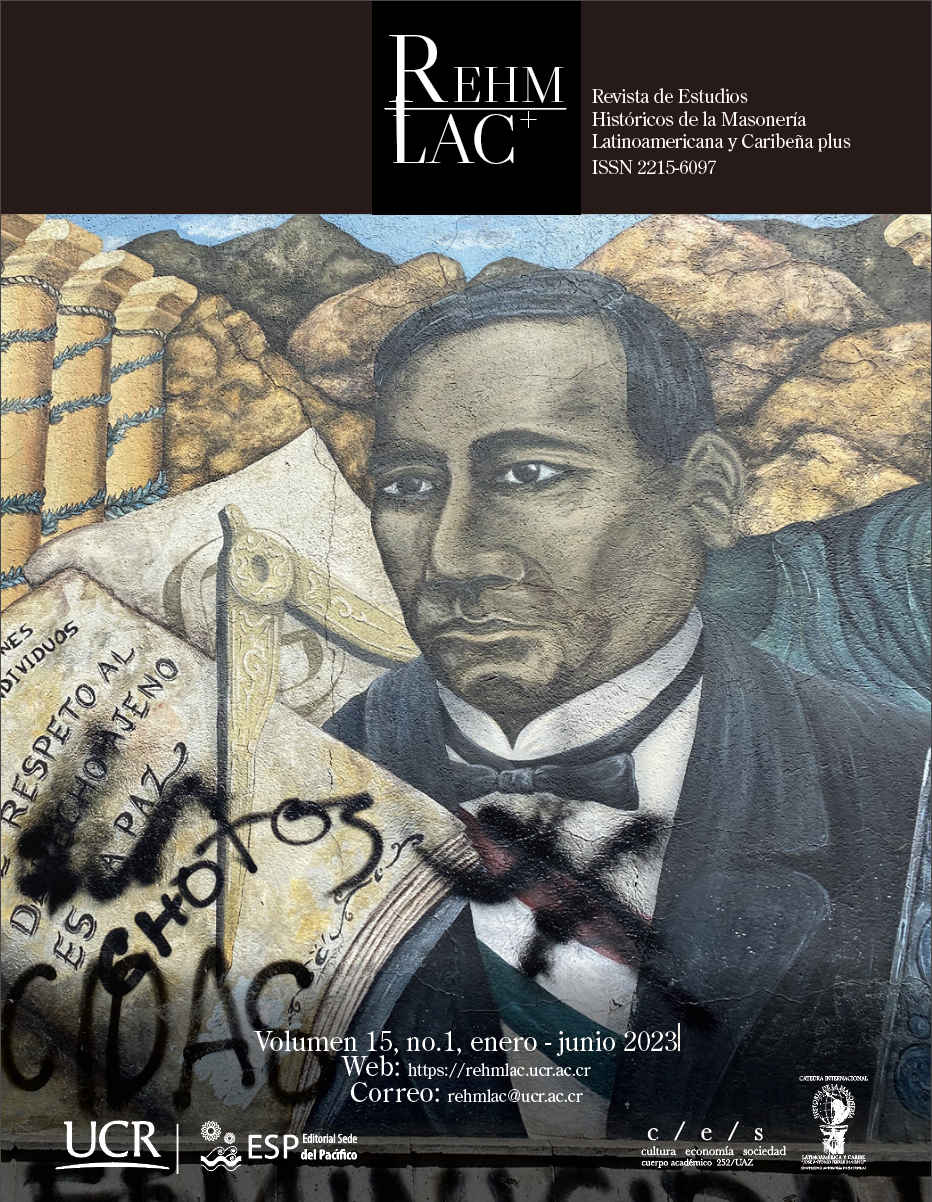Abstract
This article addresses a highly detailed and complex lithograph with the title Aperçu de l’Origine du Culte Hébraïque (“An Overview of the Origin of Hebrew Worship”), which was designed and executed in Paris in 1841 by a Hungarian rabbi, David Rosenberg. It explains the Kabbalistic meaning of the lithograph and its application to Freemasonry. Rosenberg’s endeavour will be analysed within the wider Masonic historical context. The probable reasons behind the reinterpretation of the lithograph from a Judaic into a Masonic work will be explored, thus also including Rosenberg’s possible personal motives.
References
Bibliografía
Archives israélites de France, Nouvelles littéraires, sección de Francia, (octubre de 1840).
Ben Shimon Halevi, Z’ev. Kabbalah: Tradition of Hidden Knowledge. London: Thames & Hudson, 1979.
Brach, Jean-Pierre, Pierre Mollier. “Franc-Maçonnerie et Kabbale: les planches théosophico-maçonniques du Frère David Rosenberg (circa 1830)”, Renaissance Traditionnelle, 143-144 (julio-octubre 2005).
Beresiner, Yasha. “Globes (and Maps) in Freemasonry”, Ars Quatuor Coronatorum. Transactions of Quatuor Coronati Lodge No. 2076, 102 (1989).
Carr, Harry. “Pillars and Globes, Columns and Candlesticks”. Ars Quatuor Coronatorum. Transactions of Quatuor Coronati Lodge No. 2076, 75 (1962).
De Grantham, T. (R. T. G.). “Some Reflections on Freemasonry.” Carta al editor, Freemasons’ Quarterly Review (marzo 31 de 1842).
Fidus. “The Library and Museum. Science Aided by Poverty”. Freemasons’ Quarterly Review (septiembre 30 de 1844).
Freemasons’ Monthly Magazine. “Masonic Intelligence” (1 de mayo de 1842).
Freemasons’ Quarterly Review. “Paris” sección “Foreign” (31 de marzo de 1842).
Gikatila, Joseph (con notas de Joseph Ben Shlomo). Sha’are Orah [en hebreo]. Jerusalem: Bialik Institute, 1970.
Gillen, Mollie. Royal Duke: Augustus Frederick, Duke of Sussex (1773–1843). Londres: Sidgwick and Jackson, 1978.
Hayman, Peter. Sefer Yesira: Edition, Translation and Text-Critical Commentary. Tübingen: Mohr Siebeck, 2004.
Hoffmann, Stefan-Ludwig. “Brothers or Strangers? Jews and Freemasons in Nineteenth- Century Germany,” German History 18, 2 (abril 1 de 2000).
James, P. R. “The Grand-Mastership of H.R.H. The Duke of Sussex, 1813–1843,” Ars Quatuor Coronatorum. Transactions of Quatuor Coronati Lodge No. 2076, 75 (1962).
Jewish Museum London, “Kabbalistic Mizrach”, C 1986.7.10 (litografía).
Katz, Jacob. Jews and Freemasons in Europe, 1723–1939. Cambridge, MA: Harvard University Press, 1970.
L. Beck, Guy. “Celestial Lodge Above: The Temple of Solomon in Jerusalem as a Religious Symbol in Freemasonry”. Nova Religio: The Journal of Alternative and Emergent Religions 4, 1 (octubre de 2000).
Marx, Dalia. “The Missing Temple: The Status of the Temple in Jewish Culture Following Its Destruction”. European Judaism: A Journal for the New Europe 46, 2 (otoño de 2013).
Mizrah: Compass for the Heart. Nueva York: Hebrew Union College–Jewish Institute of Religion, 1985.
Mollier, Pierre. “Freemasonry and Templarism”. Handbook of Freemasonry, editores Henrik Bogdan y J. A. M. Snoek. Leiden: Brill, 2014.
Morais, Henry Samuel. Eminent Israelites of the Nineteenth Century. Filadelfia: Edward Stern, 1880.
Myticum Sapientiae Speculum (“The Mysterious Mirror of Wisdom”) [litografía], Bruselas, 1829. Review of Literature, &c. Freemasons’
Quarterly Review. “An Emblematical Tablet on Freemasonry” (30 de septiembre de 1841).
Rosenberg, David. Explication du tableau intitulé: Aperçu de l’Origine du Culte Hébraïque, avec l’exposé de quelques usages et leurs significations symboliques. París: L’imprimerie de Crapelet, 1841.
Rosenberg, David. “Explanation of an Engraving on the Origin of the Jewish Religion, as Connected with the Mysteries of Freemasonry,” Freemasons’ Quarterly Review (marzo 31 de 1842).
Rosenberg, David. Explication du tableau maçonnique intitulé le Miroir de la Sagesse. (“Explication of the Masonic table entitled the Mirror of Wisdom”) (Paris: Imprimerie de Migneret, 1834).
Rosenberg, David. “Masonic Tableaux, an Engraving, Illustrating the Origin of the Jewish Religion, as Connected with the Mysteries of Freemasonry”, Freemasons’ Monthly Magazine (septiembre 1 de 1842).
Rosenberg, David. “Origin of the Mosaic or Jewish Religion. Large Engraving in Paris, on Grand Eagle Paper”. Freemasons’ Quarterly Advertiser (junio 30 de 1841).
Rosenberg, David. Origin of the Rites and Worship of the Hebrews. Nueva York: Max Wolff, 1859.
Rosenberg, David. “Tableau Cult de Hébraïque” (carta al editor). Freemasons’ Quarterly Review (marzo 31 de 1844).
Schmidt-Biggemann, Wilhelm. Geschichte der christlichen Kabbala, Band 1: 15. und 16.
Jahrhundert. Clavis Pansophiae 10.1. Stuttgart-Bad Cannstatt: Frommann-Holzboog, 2012.
Scholem, Gershom. Kabbalah. Jerusalén: Kéter Editorial, 1974.
Shadur, Joseph y Yehudit. Traditional Jewish Papercuts: An Inner World of Art and Symbol. Hannover & Londres: University Press of New England, 2002.
Tishby, Isaiah. The Wisdom of the Zohar. An Anthology of Texts, vol. 1. Oxford: The Littman Library & Oxford University Press, 1949.
Trepp, Leo. Die Oldenburger Judenschaft. Bild und Vorbild jüdischen Seins und Werdens in Deutschland. Oldemburgo: Heinz Holzberg Verlag, 1973.
Wolff, Max. Explication of an Engraving Called the Origin of the Rites and Worship of the Hebrews; Together with Remarks on Creation, and a Brief Account on Some Observances and Their Symbolical Signification. From the Original French of D. Rosenberg, of Paris. Nueva York: Office of the Jewish Messenger, 1859.
Wolff, Max. Explication of an Engraving Called the Origin of the Rites and Worship of the Hebrews; Together with Remarks on Creation, and a Brief Account on Some Observances and Their Symbolical Signification. From the Original French of D. Rosenberg, of Paris. Nueva York: J. A. H. Hasbrouck & Co. Printers and Stationers, 1861.
##plugins.facebook.comentarios##

This work is licensed under a Creative Commons Attribution-NonCommercial-ShareAlike 4.0 International License.
Copyright (c) 2023 REHMLAC +, Journal of Historical Studies of Latin American and Caribbean Freemasonry plus

